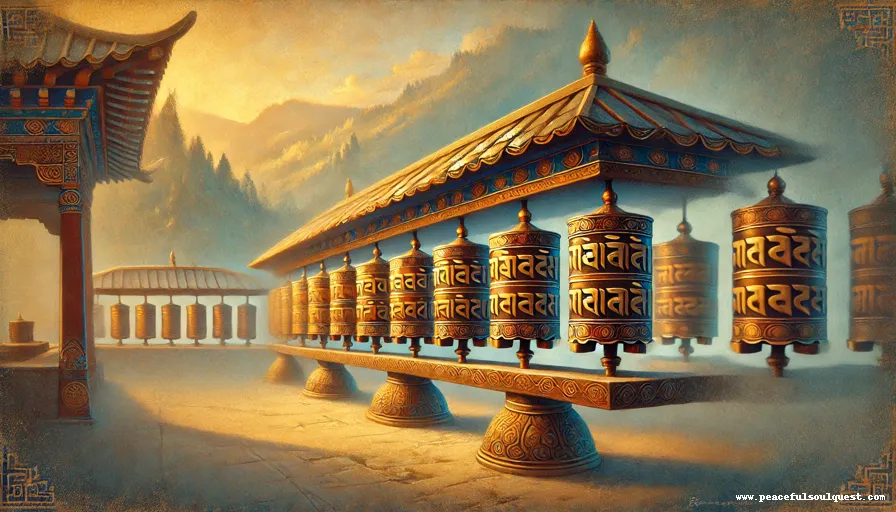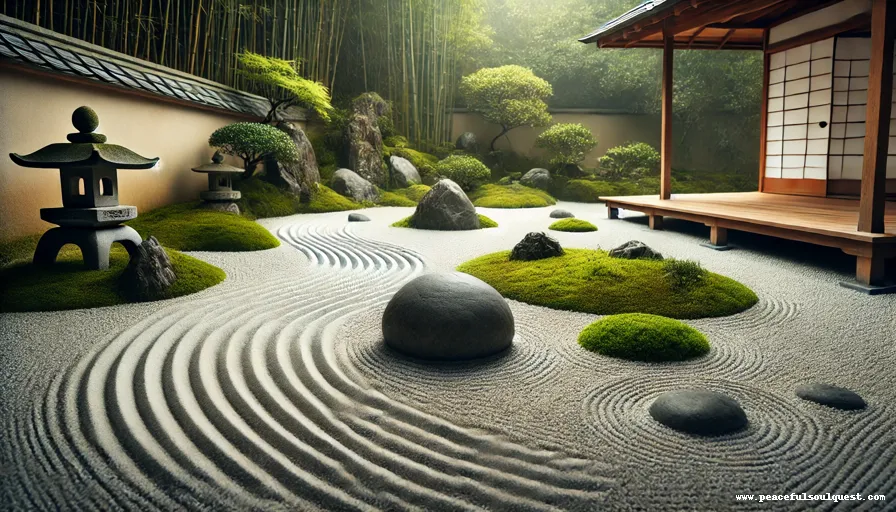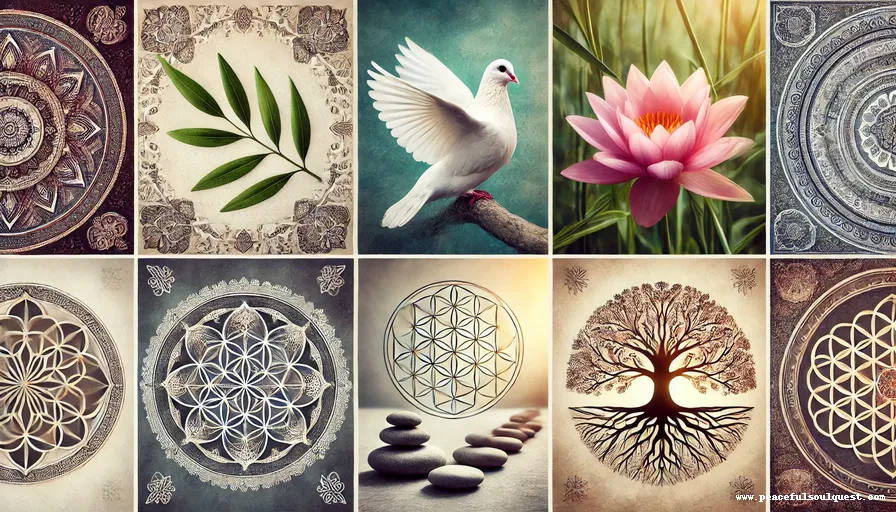Symbols of Serenity are like the secret ingredients to a peaceful life recipe. Imagine holding onto a simple object that instantly brings calm. That’s the magic of these symbols.
Curious about how a dove or lotus flower could bring you peace? Keep reading to discover the symbols that could change your life.
What is Serenity?
Serenity is often described as a state of calmness, peace, and untroubled tranquility. When we talk about serenity, we’re looking at an inner stillness that remains, even in the midst of chaos.
It’s more than just the absence of noise or stress; it’s the presence of peace within oneself. In today’s fast-paced world, finding serenity can be challenging, but understanding the Symbols of Serenity can guide us toward achieving this inner peace.
Symbols of Serenity are powerful tools that guide us in cultivating a serene state of mind.
Importance of Symbols in Representing Serenity
Symbols have been used throughout history to represent complex ideas and emotions. When it comes to serenity, symbols play a crucial role in visualizing and achieving this peaceful state.
They serve as visual reminders of the qualities and practices that can bring us closer to serenity.
By surrounding ourselves with Symbols of Serenity, we can create an environment that promotes calmness and inner peace.
These symbols are not just decorative; they are imbued with meaning and have the power to influence our mindset and emotions.
Historical Perspective on Serenity Symbols
Ancient Civilizations and Symbols of Peace
Many ancient civilizations recognized the power of symbols in conveying deep meanings. In these cultures, Symbols of Serenity were often intertwined with the symbols of peace.
For example, in ancient Greece, the olive branch was a well-known symbol of peace and victory, representing the calming end of conflict.
Similarly in Rome, the goddess Pax was a Symbol of Serenity embodying peace and tranquility, and her image was used to promote civic harmony.
These early uses of symbols helped set the foundation for how we understand and use symbols today.
Greek and Roman Symbols
In ancient Greece and Rome, the olive branch was revered as a symbol of peace and serenity. When offered, it was seen as an act of reconciliation.
The olive branch is one of the oldest Symbols of Serenity, and it was used in various ceremonies and rituals to mark the end of disputes.
In Roman culture, the goddess Pax, often depicted holding an olive branch, symbolized peace. Her presence in art and coinage was a constant reminder of the importance of serenity in society.
Asian Influences
In Asia, symbols like the Lotus Flower and Buddha have been central to the idea of serenity.
The lotus flower, which rises above muddy waters to bloom in pure beauty, symbolizes purity, peace, and resilience in many Eastern traditions.
Similarly, the Buddha is a universal symbol of inner peace and spiritual enlightenment. These symbols have transcended their cultural origins and are now recognized worldwide as emblems of serenity.
Evolution of Serenity Symbols Over Time
As societies evolved, so did the Symbols of Serenity. What began as simple representations of peace in ancient times gradually evolved into more complex and varied symbols.
For example, the Mandala, originating in ancient India, has become a global symbol of harmony and balance, often used in meditation practices to achieve serenity.
The Infinity Symbol, with its loops signifying endlessness, has also emerged as a modern representation of eternal peace and calmness.
This evolution shows how the concept of serenity is timeless, yet adaptable to different cultures and eras.
Common Symbols of Serenity and Their Meanings
Nature-Based Symbols
Nature has always been a source of inspiration for symbols representing peace and serenity. Elements like water, trees, and flowers are often used to symbolize a calm and serene state of mind.
These Symbols of Serenity draw from the natural world to convey the idea of harmony and balance, which are essential for achieving inner peace.
The Dove
The dove is perhaps the most universally recognized symbol of peace and serenity. It has been used in various cultures and religions to represent the Holy Spirit, purity, and tranquility.
In Christian symbolism, the dove with an olive branch represents peace and the end of conflict. This symbol’s gentle and calm demeanor makes it a perfect representation of serenity.

The Olive Branch
The olive branch is another ancient symbol that has stood the test of time as a representation of peace and serenity.
Originating from Greek and Roman cultures, it was traditionally given to signify the end of hostilities and the beginning of peaceful relations.
Today, the olive branch continues to be a powerful symbol of reconciliation and calm, often used in international diplomacy.
Water (Lakes, Rivers, and Waterfalls)
Water is a powerful symbol of serenity due to its calming and purifying nature. The sound of flowing water, whether from a river, lake, or waterfall, can bring a sense of peace and tranquility.
Many people incorporate water features into their living spaces to create a serene atmosphere. Water’s ability to cleanse and refresh makes it a universal symbol of renewal and inner peace.
Lotus Flower

The Lotus Flower is a symbol of purity and spiritual awakening in many Asian cultures. Despite growing in muddy waters, it blooms into a beautiful, pristine flower, symbolizing the ability to rise above challenges and achieve serenity.
The lotus represents the journey towards enlightenment and inner peace, making it a powerful symbol of serenity.
The Tree of Life
The Tree of Life symbolizes growth, strength, and connection to the earth. Its roots represent stability, while its branches reach towards the sky, symbolizing aspirations and spiritual growth.
In many cultures, the Tree of Life is seen as a symbol of eternal life and serenity. It reminds us to stay grounded while reaching for our highest potential, creating a balance that leads to inner peace.
Sacred Geometry and Serenity
Sacred geometry is the use of geometric patterns and shapes that are believed to have spiritual significance.
These shapes are often seen as representations of the underlying structure of the universe, and many of them are recognized as Symbols of Serenity.
They remind us of the harmony and balance found in nature, encouraging a calm and serene state of mind.
Mandala
The Mandala is one of the most well-known symbols in sacred geometry. It typically features a circular design with intricate patterns that radiate from the center, symbolizing the universe.
In many spiritual traditions, creating or meditating on a mandala is a practice used to bring about inner peace and serenity.
The act of focusing on the mandala helps to quiet the mind and center one’s thoughts, making it a powerful tool for achieving tranquility.
Labyrinth

The Labyrinth is another symbol with deep spiritual significance. Unlike a maze, which is designed to confuse, a labyrinth has a single, winding path that leads to the center and back out again.
Walking a labyrinth is often used as a form of moving meditation, promoting a sense of calm and introspection.
The journey to the center of the labyrinth and back out again symbolizes the journey to inner peace, making it a profound symbol of serenity.
Infinity Symbol

The Infinity Symbol, often depicted as a figure eight lying on its side, represents eternity and the infinite nature of the universe.
It is a symbol of balance and harmony, reflecting the continuous cycle of life. When used as a Symbol of Serenity, the infinity symbol reminds us of the eternal peace that can be found within ourselves, even in the midst of life’s constant changes.
Spiral
The Spiral is a pattern commonly found in nature, from shells to galaxies. It represents growth, change, and the cyclical nature of life.
The spiral is often seen as a symbol of spiritual development, guiding us towards enlightenment and inner peace.
Its continuous, flowing form embodies the essence of serenity, reminding us to stay calm and centered as we navigate the twists and turns of life.
Common Symbols of Serenity and Their Meanings
| Symbol | Culture/Origin | Meaning | Usage in Modern Times |
|---|---|---|---|
| Dove | Christianity | Peace, tranquility, and the Holy Spirit | Used in religious symbols, peace movements, and art |
| Olive Branch | Ancient Greece/Rome | Peace, reconciliation, and victory | Commonly seen in diplomacy and peace treaties |
| Lotus Flower | Buddhism/Hinduism | Purity, spiritual awakening, and resilience | Used in meditation practices and spiritual art |
| Mandala | Ancient India | Harmony, balance, and the universe | Featured in meditation and art therapy |
| Tree of Life | Various Cultures | Growth, strength, and connection to the earth | Used in various forms of art, jewelry, and decor |
| Infinity Symbol | Various Cultures | Eternity, balance, and the infinite nature of the universe | Popular in jewelry, tattoos, and logos |
Cultural and Religious Symbols
Different cultures and religions have their own unique symbols that represent serenity. These symbols often carry deep spiritual meaning and are used in various practices to promote peace and tranquility.
Understanding these symbols can help us connect with different traditions and incorporate their teachings into our own lives.
Buddha and Buddhist Symbols
In Buddhism, the Buddha is a universal symbol of enlightenment and serenity. Images of the Buddha in meditation are reminders of the peace and tranquility that can be achieved through spiritual practice.
Other Buddhist symbols, such as the Dharma Wheel and the Lotus Flower, also represent serenity and the path to enlightenment.
These symbols are often used in meditation and prayer to cultivate inner peace.
Prayer Wheels

Prayer Wheels are another significant symbol in Buddhism. These cylindrical wheels are inscribed with mantras and are spun to release the prayers into the universe.
The act of spinning a prayer wheel is a form of meditation that helps to calm the mind and bring about a sense of serenity.
This practice embodies the Buddhist belief in the power of intention and the importance of inner peace.
The Unalome
The Unalome is a symbol that represents the path to enlightenment. It starts with a spiral, symbolizing the struggle with life’s challenges, and ends in a straight line, representing the achievement of peace and enlightenment.
This symbol is often used in tattoos and art as a reminder of the journey towards serenity and the importance of staying focused on one’s spiritual goals.
Global Variations in Serenity Symbols
| Symbol | Culture | Meaning | Key Characteristics |
|---|---|---|---|
| Lotus Flower | Eastern | Spiritual awakening and purity | Represents rising above challenges |
| Buddha | Eastern | Enlightenment and inner peace | Symbolizes meditation and mindfulness |
| Dove | Western | Peace and the Holy Spirit | Represents calmness and divine presence |
| Olive Branch | Western | Reconciliation and peace | Symbolizes the end of conflict |
| Peace Sign | Western | Peace and anti-war activism | Represents harmony and non-violence |
| Unalome | Eastern | Path to enlightenment | Represents the journey from struggle to enlightenment |
Symbolism in Art and Architecture
Art and architecture have long been mediums through which symbols of serenity are expressed.
These symbols are often incorporated into the design of spaces intended for reflection and meditation, helping to create an environment of peace and tranquility.
Zen Gardens

Zen Gardens, also known as Japanese rock gardens, are designed to promote serenity and mindfulness.
These gardens typically feature carefully arranged rocks, sand, and minimal plant life. The simple, yet deliberate design of a Zen garden is meant to evoke a sense of calm and contemplation.
Raking the sand into patterns is a meditative practice that helps to quiet the mind and focus on the present moment.
Stained Glass Windows

Stained Glass Windows have been used in churches and other sacred spaces for centuries to symbolize spiritual truths and inspire serenity.
The colorful light that filters through these windows creates a peaceful atmosphere, encouraging reflection and contemplation.
The images depicted in stained glass, often of religious figures or symbols, serve as reminders of spiritual serenity and the presence of peace.
Iconography in Temples and Churches
Religious buildings, such as temples and churches, are often adorned with symbols of serenity. These can include sacred icons, sculptures, and other forms of art that represent peace and spiritual calm.
The use of such symbols in these spaces is intended to create an environment that supports worship, meditation, and the pursuit of inner peace.
Modern Interpretations of Serenity Symbols
Contemporary Usage in Design and Decor
In modern times, Symbols of Serenity have found their way into various aspects of design and decor.
Whether in homes, offices, or public spaces, these symbols are used to create environments that promote calmness and well-being.
Feng Shui Practices
Feng Shui is an ancient Chinese practice that involves arranging spaces to harmonize with the natural world. In Feng Shui, certain objects and symbols are used to promote serenity and balance.
For example, placing a water feature in the home is believed to bring peace and calm to the inhabitants. By incorporating these practices, one can create a serene and harmonious living space.
Incorporating Serenity Symbols in Home Decor
Many people use Symbols of Serenity in their home decor to create a peaceful atmosphere.
Items such as candles, incense burners, and artwork featuring serene imagery can help to transform a space into a sanctuary of calm.
Choosing decor that reflects these symbols can enhance the feeling of tranquility in any room.
Use in Branding and Commercial Art
Brands and businesses often use Symbols of Serenity in their logos and advertising to convey a sense of calm and trustworthiness.
For instance, companies in the wellness and health industries frequently use symbols like the lotus flower or the infinity symbol to represent peace and well-being.
These symbols help to create a positive association with the brand, appealing to consumers’ desire for serenity.
Tattoos and Personal Adornments
Tattoos and other forms of personal adornment are popular ways to carry Symbols of Serenity with you wherever you go.
These symbols serve as constant reminders of the importance of inner peace and the journey towards it.
Popular Serenity Symbols in Tattoos
Tattoo designs often feature Symbols of Serenity like the Unalome, lotus flower, and infinity symbol due to their peaceful associations.
These tattoos not only have personal significance but also serve as daily reminders to stay calm and centered.
Symbolism in Jewelry and Fashion
Wearing jewelry that features Symbols of Serenity is another way to keep these powerful reminders close at hand.
Necklaces, bracelets, and rings adorned with symbols like the peace sign or mandala can serve as both stylish accessories and tools for promoting inner calm.
Digital and Social Media Representation
In the digital age, Symbols of Serenity have also found their place in social media and online platforms.
These symbols are often used in posts, emojis, and apps designed to promote mindfulness and relaxation.
Emojis and Their Meanings
Emojis, such as the peace sign or meditation emoji, are widely used in digital communication to convey a sense of calm and serenity.
These simple symbols can be a quick and effective way to express peaceful intentions in our everyday interactions.
Use of Symbols in Mindfulness Apps
Many mindfulness and meditation apps incorporate Symbols of Serenity into their design to create a calming user experience.
These apps often feature images of mandalas, lotus flowers, and other symbols as visual aids to help users achieve a state of relaxation and inner peace.
Psychological Impact of Serenity Symbols
Role in Meditation and Mindfulness Practices
Symbols of Serenity play a vital role in meditation and mindfulness practices. When we meditate, we often use symbols as focal points to anchor our thoughts and guide our minds towards calmness.
For example, visualizing a mandala or focusing on the image of a lotus flower can help deepen meditation by providing a tangible representation of serenity.
These symbols remind us to stay present, release tension, and cultivate inner peace.
In mindfulness practices, symbols like the infinity symbol or the Unalome are used to represent the continuous journey toward balance and enlightenment.
By incorporating these symbols into our daily routines, we can reinforce the practice of mindfulness, making it easier to maintain a serene state of mind even in challenging situations.
Visualization Techniques
Visualization is a powerful technique used in meditation to achieve serenity. When you visualize Symbols of Serenity, you create a mental image that helps you focus and calm your thoughts.
For instance, imagining a calm lake or a flowing river can evoke feelings of peace and tranquility.
This practice can be particularly effective when dealing with stress or anxiety, as it allows you to mentally transport yourself to a serene place.
Another popular visualization technique involves the mandala. By picturing the intricate patterns and harmonious symmetry of a mandala, you can bring your mind into a state of balance and calm.
This technique is often used in guided meditations to help participants achieve a deeper level of serenity.
Use in Guided Meditations
Guided meditations often incorporate Symbols of Serenity to help participants reach a state of relaxation and inner peace.
In these meditations, the guide might describe a peaceful scene featuring symbols like a tree of life or a zen garden.
By visualizing these symbols, participants can connect with their inner calm, making it easier to let go of stress and find serenity.
These symbols not only enhance the meditation experience but also serve as tools for cultivating long-term mental well-being.
By regularly engaging with these symbols during meditation, individuals can develop a stronger sense of serenity that persists beyond the meditation session.
Therapeutic Benefits of Surrounding Oneself with Serenity Symbols
Surrounding yourself with Symbols of Serenity can have significant therapeutic benefits.
These symbols can transform your environment into a sanctuary of peace, helping to reduce stress, improve focus, and enhance overall well-being.
Stress Reduction
One of the primary benefits of incorporating Symbols of Serenity into your environment is stress reduction. Visual reminders of peace, such as doves or lotus flowers, can have a calming effect on the mind.
When placed in your living space or workspace, these symbols can serve as a constant reminder to breathe, relax, and let go of tension.
For instance, having a water feature in your home, such as a small fountain, can mimic the soothing sounds of nature, helping to create a serene atmosphere.
These sounds, combined with the visual symbolism of water as a source of life and renewal, can significantly reduce stress levels.
Enhancing Focus and Clarity
In addition to reducing stress, Symbols of Serenity can also enhance focus and clarity. When your mind is cluttered or overwhelmed, focusing on a symbol like the infinity symbol or the spiral can help you regain mental clarity.
These symbols are simple yet profound, encouraging you to find balance and maintain perspective.
Moreover, having symbols like the tree of life or a labyrinth in your environment can remind you of the bigger picture, helping you to stay grounded and focused on your goals.
This can be particularly beneficial in work environments where maintaining focus is crucial.
Global Variations in Serenity Symbols
Eastern vs. Western Symbols of Serenity
Symbols of Serenity vary widely between Eastern and Western cultures, each offering unique perspectives on what it means to live a serene life.
In Eastern traditions, symbols like the lotus flower and Buddha represent spiritual enlightenment and inner peace. These symbols emphasize the importance of meditation and mindfulness in achieving serenity.
In contrast, Western symbols of serenity often focus on peace in a social or political context. Symbols like the dove and the olive branch are commonly associated with peace treaties and diplomatic efforts.
These symbols reflect the Western emphasis on external harmony as a pathway to inner peace.
Comparison of Symbolism in Different Cultures
While both Eastern and Western cultures value serenity, their symbols and interpretations differ significantly.
For example, the Mandala in Eastern traditions is a symbol of the universe’s harmony, used in spiritual practices to foster inner peace.
In the West, the peace sign, originally designed for nuclear disarmament, has become a broader symbol of societal peace and unity.
Despite these differences, there is a shared understanding that symbols have the power to evoke feelings of calmness and serenity.
By exploring the symbols of different cultures, we can gain a deeper appreciation of the universal quest for peace.
Regional and Indigenous Symbols
In addition to the well-known symbols from Eastern and Western cultures, many regions and indigenous groups have their own Symbols of Serenity.
These symbols often draw from nature and local traditions, offering unique insights into how different cultures view peace and tranquility.
Native American Symbols
Native American cultures have a rich tradition of using symbols to represent peace and harmony with nature.
For example, the dreamcatcher is often seen as a symbol of protection and serenity, believed to filter out bad dreams and negative energy.
The feather, another important symbol, represents freedom, peace, and a connection to the spiritual world.
These symbols are deeply rooted in the natural world, reflecting the Native American belief in living in harmony with nature to achieve serenity.
Incorporating these symbols into your life can help you connect with these ancient traditions and find your own path to peace.
African and Tribal Symbols
In African and other tribal cultures, symbols are used to convey important spiritual and cultural messages.
The Adinkra symbols from West Africa, for example, include symbols like Nyame Nwu Na Mawu, meaning “God never dies, therefore I shall not die,” which embodies the concept of eternal peace.
Another example is the **spiral** found in many tribal designs, symbolizing life’s journey and the quest for balance and peace.
These symbols often have dual meanings, representing both the physical and spiritual aspects of life.
By understanding and incorporating these symbols, we can gain a deeper connection to the cultural practices that emphasize serenity.
How to Incorporate Serenity Symbols into Daily Life
Creating a Personal Sanctuary
Incorporating Symbols of Serenity into your daily life can start with creating a personal sanctuary.
This is a space in your home dedicated to peace and tranquility, where you can retreat to find calm in the midst of daily stress.
Designing a Space for Peace
To design a space for peace, start by choosing Symbols of Serenity that resonate with you. This could include items like a mandala tapestry, a small fountain, or a Buddha statue.
Arrange these symbols in a way that creates a calming environment, focusing on simplicity and balance.
Consider the use of natural elements, such as plants or water features, which can enhance the feeling of serenity. Soft lighting and comfortable seating can also help transform your space into a true sanctuary.
Selecting the Right Symbols
Selecting the right Symbols of Serenity is a personal process. Choose symbols that evoke a sense of calm and resonate with your spiritual or cultural beliefs.
For some, the lotus flower might represent the purity and resilience needed to stay serene. For others, a simple *design might symbolize the ongoing journey towards peace.
Experiment with different symbols to see which ones have the most calming effect on you. Remember, the goal is to create an environment that supports your mental and emotional well-being.
Daily Rituals Involving Serenity Symbols
Incorporating Symbols of Serenity into your daily rituals can help you maintain a peaceful state of mind throughout the day.
These rituals don’t need to be elaborate; simple practices can make a significant difference.
Morning and Evening Routines
Start your day with a morning routine that includes Symbols of Serenity. This could be as simple as lighting an incense stick and taking a few moments to breathe deeply and center yourself.
Using a prayer wheel or visualizing a mandala can also be effective in setting a peaceful tone for the day.
In the evening, wind down by spending time in your sanctuary space. Engage in a calming activity like meditating with a mala bead or reflecting on the day while gazing at a mandala.
These simple routines can help you transition into a restful state, ensuring a peaceful end to your day.
Incorporating Symbols in Yoga and Meditation
Yoga and meditation are practices inherently linked to serenity, and incorporating Symbols of Serenity into these activities can enhance their effectiveness.
For example, during yoga, you might focus on a mandala or lotus flower as you move through poses, using the symbol to center your thoughts and deepen your practice.
In meditation, holding a prayer wheel or visualizing a spiral can help guide your mind to a state of calm.
These symbols serve as anchors, helping you maintain focus and achieve a deeper sense of peace during your practice.
Final Thoughts on the Power of Serenity Symbols
In a world filled with chaos and noise, Symbols of Serenity offer a much-needed reminder of the importance of peace and balance.
These symbols, rooted in both ancient traditions and modern practices, provide a timeless guide for anyone seeking to cultivate a serene state of mind.
Whether through meditation, decor, or daily rituals, these symbols help us connect with our inner calm and create an environment conducive to serenity.
By integrating these symbols into your daily life, you can create a lasting sense of peace that helps you navigate the complexities of modern living with grace and calm.
